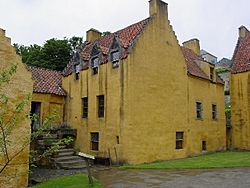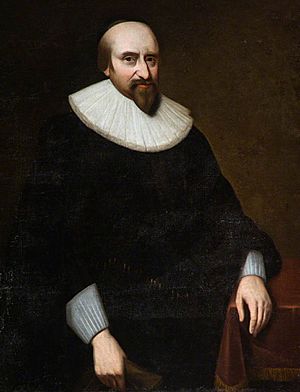George Bruce of Carnock facts for kids
Sir George Bruce of Carnock (born around 1550 – died 1625) was a clever Scottish businessman, ship owner, and engineer who made big changes in mining.
Contents
Meet George Bruce's Family
George Bruce was the son of Edward Bruce of Blairhall and Alison Reid. His older brother, Edward Bruce, became a very important person called Lord Bruce of Kinloss in 1602. While Edward built a large house called Culross House, George built the famous Culross Palace.
Amazing Innovations in Mining
George Bruce was a true pioneer in coal mining. He was one of the first to dig for coal right under the sea! He used new ways to drain water from the mines, which was a huge problem back then.
His amazing ideas caught the attention of many, even King James VI himself in 1617. Sir George Bruce invited the King to see one of his mines that went deep under the Firth of Forth. King James walked into an entrance on land and went far out under the sea. To his surprise, he came out at the top of a stone tower about a quarter of a mile from the shore!
The King was quite shocked to find himself surrounded by water. He even thought Sir George was trying to harm him and called it treason! But Sir George quickly showed him a rowing boat and explained that the King could either take the boat back or return through the tunnel. King James relaxed and chose the boat ride.
A Poet Visits the Mine
In 1618, an English writer known as John Taylor, the "Water Poet," visited Culross. Three of Bruce's workers showed him around the mine. Taylor was amazed by how the mine had an entrance on land and another through a waterproof tower built on a sandbank. He could choose to return from the tower by mine or by boat.
Taylor was so impressed that he joked that the famous Gunpowder plotters (who tried to blow up Parliament) could have learned from Bruce! He also saw a special machine, like an Egyptian wheel, that used horses to drain the mine. It had an endless chain with 36 buckets to lift out water.
Making Salt and Finding Silver
George Bruce also had many salt works. Here, sea-water was heated to make salt, which was used for seasoning food and preserving meat. Salt from Culross was sent to England and Germany.
In 1608 and 1609, Bruce was in charge of the royal silver-mine at Hilderston. He even had a place to stay there, though his deputy managed the daily work.
Shipping and Trade Adventures
George Bruce was also a big player in shipping. He helped finance trade and owned many ships.
Lost Ships and Spanish Wine
In 1583, some of Bruce's ships, the Falcon of Preston and the Jesus of Bo'ness, lost their valuable goods bought in London. English sailors took the ships. Bruce and other ship owners asked Elizabeth I to help them get their ships and goods back.
In 1598, one of Bruce's ships, the Bruce, was involved in a legal case. The ship went to Ferrol in Spain to pick up wine, figs, and raisins. The captain met some English ships that were at war with Spain. These English ships forced 52 people onto the Bruce. This case was even discussed by the English government.
In 1599, King James VI asked the King of Denmark for permission for Bruce to fish in Iceland waters. This was because the Danish King had stopped English ships from fishing there.
Later, in 1621, King James asked for help to make the Forth safer for ships. George Bruce came up with a plan for warning lights and fires on the hidden rocks. This idea was so good that other coal mine owners in the area agreed to help pay for the beacons themselves!
Building Culross Palace


Between 1597 and 1611, George Bruce built a beautiful mansion house in Culross. He used materials from his trading trips abroad. This amazing building is now known as Culross Palace. He decorated it with stunning painted ceilings and fancy features that you can still see today.
The National Trust for Scotland now looks after Culross Palace. It has been carefully restored to look just as it did in the 1600s. The outside of the palace, which was once white, has been returned to its original yellow-orange color. The garden has also been replanted with vegetables, herbs, and plants that would have grown there in the 17th century.
George Bruce also bought the Carnock estate in Fife. In 1602, he helped repair the church there.
George Bruce's Final Years
George Bruce passed away on May 6, 1625. He was buried in Culross Abbey, which is now a church.
His impressive memorial in the church shows him lying with his wife, Margaret Primrose. Below them, his eight children (three sons and five daughters) are shown praying.
Family and Legacy
George Bruce married Margaret Primrose. Her father was Archibald Primrose, and her brother, James Primrose, was an important clerk for the government.
His children included:
- George Bruce, who became the 2nd of Carnock.
- Robert Bruce of Broomhall.
- Anne Bruce, who married James Arnot.
- Christian Bruce, who married Robert Colville and later Laurence Mercer.
- Magdalene Bruce, who married John Erskine.
- Nicholas Bruce, who married John Morrison and later John Dick.
- Margaret Bruce, who married Francis Nicholls.
In 2015, Sir George Bruce was honored by being added to the Scottish Engineering Hall of Fame for all his amazing inventions and contributions.



